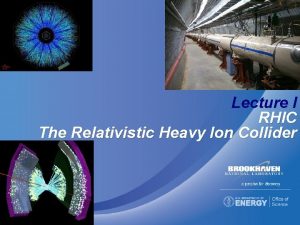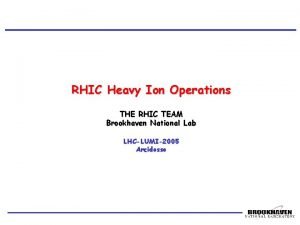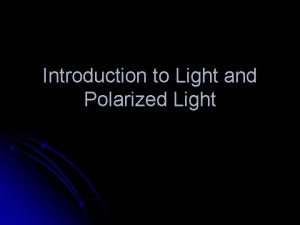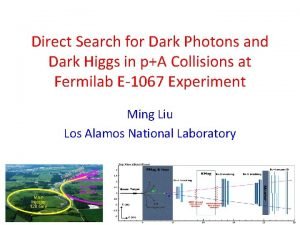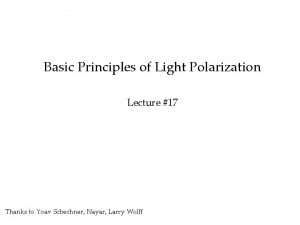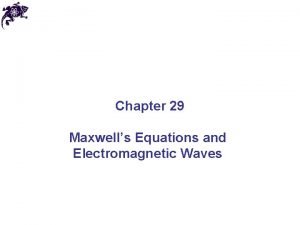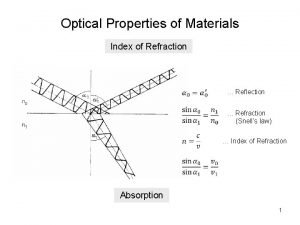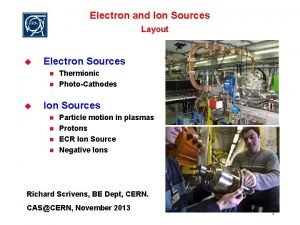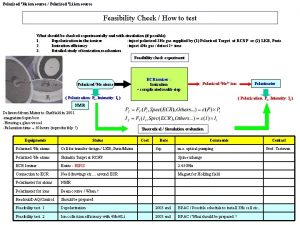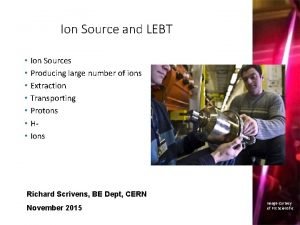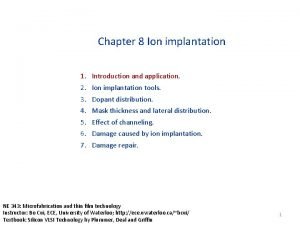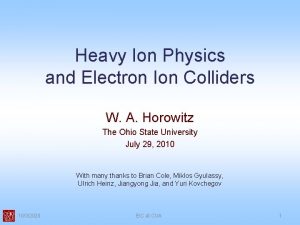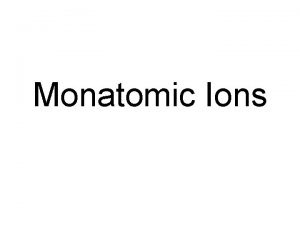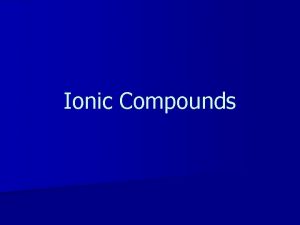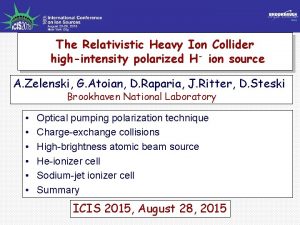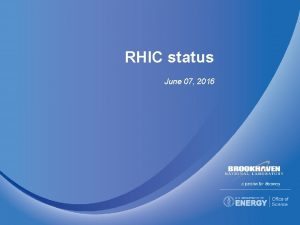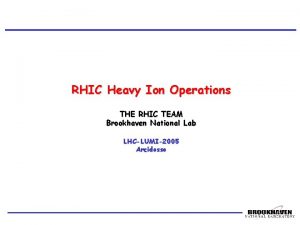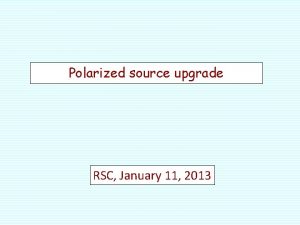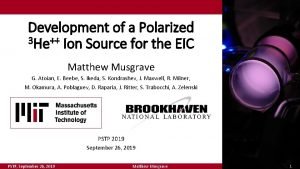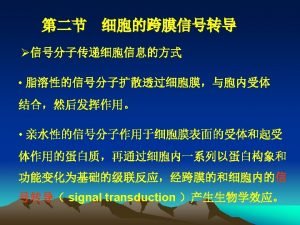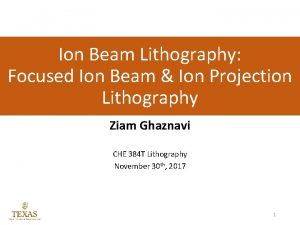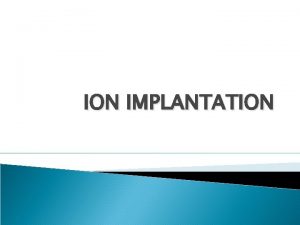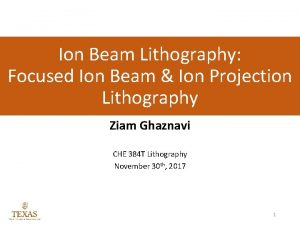OPPIS Highintensity polarized H ion source at RHIC























- Slides: 23

OPPIS: High-intensity polarized H- ion source at RHIC A. Zelenski, CAD RSC Meeting, February 20, 2015

Polarization techniques Dissociator ABS Separating 6 -pole magnet Optically. Pumped cell RF transition LDS Optical pumping OPPIS Proton source Optically. Pumped cell H 0 Source Optically. Pumped cell Polarization by electron spin Sona transition Polarization Transfer to protons ECR ionizer H+ Cs cell H- Cs beam H- Plasma ionizer H- Na cell H- He cell H+ Ionization

Depopulation Optical Pumping m 5 n λ 9 =7 l 1. 56 e. V r ula o y. P la t d e riz rc Ci 5 P 1/2 h lig n. LJ Spontaneous decays. 5 S 1/2 MJ = -1/2 relaxation MJ = +1/2 ~ 100% polarized Rb atoms! Optical pumping application is limited by available laser wavelenghes!? Recent progress in laser technology is very promising for new applications. W. Happer, Rev. Mod. Phys. 44, 170 (1972)

SPIN -TRANSFER POLARIZATION IN PROTON-Rb COLLISIONS Laser-795 nm Optical pumping Rb: NL(Rb) ~1014 cm-2 Rb+ Proton source Na-jet ionizer cell: NL(Na)~ 3 • 1015 cm-2 Rb+ H+ H+ Sona transition Ionizer cell H- 1. 5 k. G field ECR-29 GHz Н+ source Supperconducting solenoid 25 к. Гс Charge-exchange collisions: ~10 -14 cm 2 Electron to proton polarization transfer Laser beam is a primary source of angular momentum: 10 W (795 nm) 4 • 1019 h /sec 2 A, H 0 equivalent intensity.

New OPPIS with atomic H 0 injector layout, 2013 CP 1 TMP 1 Neutralizer H 2 -cell He-ionizer cell Atomic H injector H+ H 2 H 0 He Rb-cell H+ Sona transition Rb H 0 Na-jet cell Na H-

The RHIC OPPIS after upgrade with atomic hydrogen injector, Run-2013 -15

“Fast Atomic Beam Source”, BINP, 2011 Plasmatron 4 -grid proton extraction system ~ 3. 5 A equivalent H 0 beam H 2 Neutralization cell FABS produces 200 -300 m. A equivalent H 0 beam intensity Within the Na-jet ionizer acceptance.

Residual un-polarized H 0 beam component suppression by the energy separation H 0 + He → H+ + He + e H 0(6. 5 ke. V) Deceleration Rb -cell He-ionizer cell H+(70%) H 0(2. 5 ke. V) H 0(30%) -4. 1 k. V -4. 0 k. V -4. 1 k. V -2 -3 k. V +0. 1 k. V H 0(6. 5 ke. V)

He-ionizer cell and 3 -grid energy separation system. He-pulsed valve 3 -grid beam deceleration system

Sodium-jet ionizer cell Transversal vapor flow in the N-jet cell. Reduces sodium vapor losses for 3 -4 orders of magnitude, which allow the cell aperture increase up to 3. 0 cm. Nozzle 500 deg. C Collector ~150 deg. C NL ~2· 1015 atoms/cm 2 L ~ 2 -3 cm Reservoir ~500 deg. C Reservoir– operational temperature. Tres. ~500 о. С. Nozzle – Tn ~500 о. С. Collector- Na-vapor condensation: Tcoll. ~120 о. С Trap- return line. T ~ 120 – 180 о. С.

H- beam acceleration to 35 ke. V at the exit of Na-jet ionizer cell H 35 ke. V H 0 39 ke. V 3 ke. V 7 kev -32 k. V -28 ke. V -15 ke. V Na-jet cell is isolated and biased to – 32 ke. V. The H- beam is accelerated in a two-stage acceleration system.

Rb-90, 200 Me. V after the Linac-620 u. A 600 µA × 400 µs → 14. 4 ∙ 1011 protons/pulse

Equal 12 deg and 16 deg polarization numbers 85. 2%

Polarization in AGS, 23 Ge. V


Polarization measurements at 255 Ge. V in H-jet polarimeter, Run-2013, April-25 -30 < ~ 62% in collisions

RHIC Polarized beam in Run 2013 -15 OPPIS 1. 0 m. A x 300 us→ 18∙ 1011 polarized H- /pulse. 9. 0 ∙ 1011 polarized H- /pulse at 200 Me. V routinely in Run-15 LINAC Booster (2. 5 -3. 0) ∙ 1011 protons /pulse at 2. 3 Ge. V AGS ~1. 8∙ 1011 p/bunch, P~60 -65% at 100 Ge. V P ~ 58% at 255 Ge. V It is expected, that use of Electron Lens will allow increase of the bunch intensity to ~2. 5∙ 1011 p/bunch. (2. 0 -2. 2) ∙ 1011 p/bunch RHIC

Backup

3 He++ ion source development at BNL in collaboration with MIT. He-3 metastabilityexchange polarized cell He-transfer line. Valve. ~50· 1011 3 He /pulse. P - 80 -90%. Pumping laser 1083 nm. 2. 5· 1011 He++/pulse He(2 S)→ He(1 S) Polarization by optical pumping EBIS-ionizer, B~ 50 k. G Ionization RFQ Linac Booster AGS 1. 5· 1011 He++/pulse RHIC


Beam. Energy=6. 5 ke. V; IONZ=220 A; Polarized H- current at 750 ke. V energy (after RFQ) vs. Rb-cell temperature 1. 0 m. A × 300 us =18× 1011 ions/pulse NL~10× 1013 atoms/cm 2 Rb cell temperature, deg. C 06 Dec, 2013 Note#31, page 75

Polarization at 200 Me. V 83. 0%

Long-term polarization stability, April 14 -23, 2014 86%
 Rhic
Rhic Rhic brookhaven
Rhic brookhaven Rhic ags users meeting 2020
Rhic ags users meeting 2020 Rhic
Rhic Uniones intermoleculares
Uniones intermoleculares What is london forces
What is london forces C6h12 fuerza intermolecular
C6h12 fuerza intermolecular Ejemplo de fuerza ion ion
Ejemplo de fuerza ion ion Light definition
Light definition Photo search
Photo search Birefrengence
Birefrengence Polarized pluralist model
Polarized pluralist model Homunculus
Homunculus Ampere maxwell law
Ampere maxwell law Non-polarizable electrode
Non-polarizable electrode Index of refraction formula with angles
Index of refraction formula with angles Ion source
Ion source An ion source is producing 6li ions
An ion source is producing 6li ions Ecr ion source
Ecr ion source Liviu rebreanu ion
Liviu rebreanu ion Ion implantation
Ion implantation Ion
Ion Monatomic ions table
Monatomic ions table Transition metals valence electrons
Transition metals valence electrons
